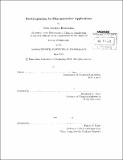| dc.contributor.advisor | Bernhardt L. Trout. | en_US |
| dc.contributor.author | Brettmann, Blair Kathryn | en_US |
| dc.contributor.other | Massachusetts Institute of Technology. Dept. of Chemical Engineering. | en_US |
| dc.date.accessioned | 2013-01-23T19:42:12Z | |
| dc.date.available | 2013-01-23T19:42:12Z | |
| dc.date.copyright | 2012 | en_US |
| dc.date.issued | 2012 | en_US |
| dc.identifier.uri | http://hdl.handle.net/1721.1/76480 | |
| dc.description | Thesis (Ph. D.)--Massachusetts Institute of Technology, Dept. of Chemical Engineering, 2012. | en_US |
| dc.description | Cataloged from PDF version of thesis. | en_US |
| dc.description | Includes bibliographical references (p. 133-149). | en_US |
| dc.description.abstract | The pharmaceutical industry is currently shifting from batch to continuous manufacturing, and for downstream processes, this shift can reduce costs and improve quality provided the new unit operations are chosen properly. Electrospinning, a method of making nanofiber mats from solutions of an active pharmaceutical ingredient (API), polymer and solvent, has shown great promise for producing final solid dosage forms with minimal process steps. In this thesis, we explore the use of electrospinning to produce fiber mats containing either amorphous or crystalline API, aiming to develop the process such that it can be used for a wide variety of final drug products. Key to utilizing electrospinning to make these products is understanding the composition and behavior of the final fiber mats. For fibers containing amorphous API, this means it is essential to understand the level of mixing between API and polymer and the stability of the final product, and for fibers containing crystalline API, the crystal morphology and extent of dispersion within the polymer must be understood. The mixing level of amorphous API and polymer in fibers was analyzed using solid state nuclear magnetic resonance relaxation times. It was found that, for aliskiren/poly(vinyl pyrrolidone) and indomethacin/poly(vinyl pyrrolidone) formulations, the materials are intimately mixed following electrospinning, with no phase separation down to a 2-10 nm domain size. This was not the case for a 4:1 aliskiren:poly(vinyl pyrrolidone) formulation prepared by hot melt extrusion, an alternative method for co-processing API and excipients, as solid state NMR analysis showed phase separation with domains of 20-80 nm or larger. The same electrospun formulations were shown to be stable as solid solutions for 6 mo. when stored at 40°C in a desiccator, indicating that electrospinning is a viable method to produce physically stable formulations containing amorphous API. To produce fibers containing crystalline API, two methods were used. In the first, an API/polymer solution was electrospun using the same method as for producing fibers containing amorphous API. It was found that spinning with a crystalline polymer can result in crystalline API in the fibers, but the crystallinity ultimately depends on more than the polymer and API properties. Due to the complexity of using this method, we developed the second method, involving electrospinning a suspension of API crystals in the polymer/solvent solution. We demonstrated the feasibility of spinning particles of up to 10pm diameter using polystyrene beads and then applied the process to electrospin two different APIs, albendazole and famotidine. The electrospun mats contained crystalline APIs well-dispersed within the fibers and tablets prepared from the mats displayed a higher dissolution rate than fibers prepared from powder blends. | en_US |
| dc.description.statementofresponsibility | by Blair Kathryn Brettmann. | en_US |
| dc.format.extent | 149 p. | en_US |
| dc.language.iso | eng | en_US |
| dc.publisher | Massachusetts Institute of Technology | en_US |
| dc.rights | M.I.T. theses are protected by
copyright. They may be viewed from this source for any purpose, but
reproduction or distribution in any format is prohibited without written
permission. See provided URL for inquiries about permission. | en_US |
| dc.rights.uri | http://dspace.mit.edu/handle/1721.1/7582 | en_US |
| dc.subject | Chemical Engineering. | en_US |
| dc.title | Electrospinning for pharmaceutical applications | en_US |
| dc.type | Thesis | en_US |
| dc.description.degree | Ph.D. | en_US |
| dc.contributor.department | Massachusetts Institute of Technology. Department of Chemical Engineering | |
| dc.identifier.oclc | 822232439 | en_US |
